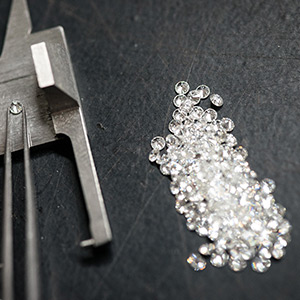
As of March 1, the United States will prohibit rough and polished diamonds that were mined in Russia and weigh one carat or more from entering the country. With the start date just 10 days away, it’s still not clear how the ban will work.
Those details are said to be in the hands of U.S. Customs and Border Protection (CBP), the agency that will enforce the new rules. Based on current G7 plans, importers bringing diamonds of at least one carat into the United States will likely have to provide an “attestation” that the diamonds weren’t mined in Russia. Importers may also need “documentary supply chain evidence”—such as invoices or other paperwork—to back up their claim.
That raises some questions: What will count as “documentary evidence”? Will it have to be presented for every shipment, or just when a Customs agent asks for it? How will the attestation be worded, and will it have legal force? How will the system handle “grandfathered” diamonds—those bought before the ban, which have no origin info? And if importers don’t have the required documentation, will their goods be confiscated or just rejected?
Those questions need to be answered in the next week and a half.
The sanctions will also probably ban shipments of polished diamonds from “mixed” locales—with the exception of goods from De Beers’ “Botswana sort” (which aggregates production from four different countries).
All of this suggests that importers will have to obtain more origin information than they currently do. Those involved in the G7 deliberations say that most importers bringing goods to the United States should already possess this information, given that Russian diamonds have generally been considered verboten in the United States since the invasion of Ukraine. (The U.S. Treasury’s Office of Foreign Assets Control has put sanctions on the main Russian miners.) So it’s just a matter of U.S. companies adhering to their prior commitments not to sell Russian gems.
Given the short time frame before the ban—and the general desire not to hurt the trade or overwhelm Customs agents—most people working on the G7 plan say it may be, at least at first, relatively easy to comply with (it likely won’t apply to diamond jewelry). And while it’s possible March 1 will be a huge shock for the industry, it’s generally believed that the “sunrise period” (lasting through Aug. 31) will give both the industry and the G7 six months to get their act together.
March 1 will also mark the kickoff of the G7 certification pilot, which several companies have already enrolled in. The certification system has been overseen by Antwerp World Diamond Centre, which brought in GIA (at the urging of the State Department), who in turn enlisted diamond tech company Everledger in the effort.
G7 certification will be optional from March through August, and could serve as the required “documentary supply chain evidence” for importers during the pre-September interregnum. On Sept. 1, use of the G7 certification system will become mandatory—though that date might get pushed back.
While G7 statements have called the certification mechanism a “blockchain ledger,” sources describe the system set up by GIA as more of a “browser,” which will take information from all the different tracking systems (Tracr, Sarine, Everledger, etc.) and make it accessible to Customs agents. The G7 will decide how that information is stored and retained. Regardless, the new system will require anyone importing polished to a G7 nation to use a tracking service.
One controversial aspect of the G7 plan involves a prospective “rough node”—a requirement, beginning in September, for all rough that will create polished (a half carat or larger) meant for G7 countries to be routed through Antwerp’s Diamond Office. Supporters of this concept contend a physical check is essential to maintain the system’s integrity. (“Beneficiated” goods—diamonds polished in the same country they were mined—will be allowed to skip the node.)
Opponents of the rough node, including many industry groups and producer countries, say the Antwerp node would create a time and money burden, which would inadvertently penalize dealers in non-Russian goods. They see it as Belgium’s way of potentially making up for the business it will lose by closing its borders to Russian rough.
The G7 might okay other “rough nodes,” in diamond-producing countries such as Canada (a G7 member) and Botswana. But those backing the Antwerp node worry that if the G7 puts a node in Botswana, it would need a reason to not set up one in Namibia, Angola, and so on—and with so many nodes, the system would become decentralized and watered down.
There’s also no agreement yet on whether sanctions will expand to include diamond watches, diamond jewelry, and lab-grown diamonds; a recent European Union statement said all of those would be covered.
Sources say the current thinking is that diamond watches and lab-grown diamonds will probably not be hit, as most watches use melee diamonds, and most lab-growns are low-value and not produced in Russia. However, excluding diamond jewelry could open up a loophole—importers would simply plop their diamonds in one-dollar mountings, and they won’t be checked.
According to one participant, those involved in planning the G7 sanctions have been meeting five or six times a week in the run-up to the March 1 deadline, yet most meetings end with issues undecided. This person even compared the deliberations to the Kimberley Process—the diamond certification scheme that’s become so notoriously static it didn’t even release a final statement after its last meeting.
Of course, while the Kimberley Process is composed of 90 nations, the G7 has just seven, plus the European Union (which is said to be the main force pushing the diamond sanctions). The G7 countries are allies, and they all support Ukraine and want to see an end to the war. But their deliberations on diamonds have revealed plenty of agendas and counter-agendas, all while trying to regulate an industry that can be just as fractious and turf-conscious.
As frustrating as these deliberations have been, some say the trade is lucky that governments are consulting it.
“Most industries, they learn about sanctions in the newspaper,” says one person active behind the scenes. “Here, they have really listened to industry.”
And the industry has no choice but to listen to the G7. But with March 1 approaching, the feeling is: The clock is ticking, and we need to hear something, quick.
(Photo: Getty Images)
- Subscribe to the JCK News Daily
- Subscribe to the JCK Special Report
- Follow JCK on Instagram: @jckmagazine
- Follow JCK on X: @jckmagazine
- Follow JCK on Facebook: @jckmagazine






